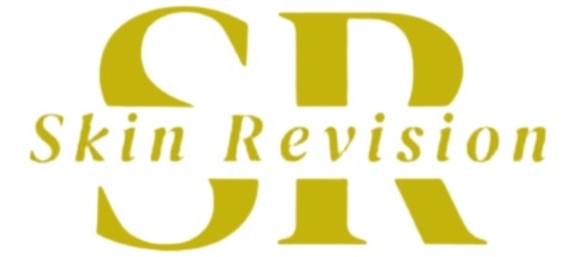What are Cherry Angiomas?
Cherry Angiomas are common, benign skin growths that appear as bright red or purple spots on the skin. Often small, but occasionally larger, these harmless vascular lesions can be a cosmetic concern, especially when they develop on visible areas like the face, neck, legs arms or chest. Fortunately, Skin Revision offers an advanced, non-invasive treatment that reduces their appearance, helping you achieve blemish- free toned skin.
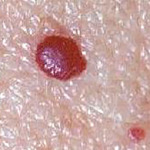
In this article, we explore the cause of cherry angiomas, what symptoms to look out for, and the best treatment options to help reduce or remove these skin growths.
Cherry angiomas (can also referred to as Blood Spots, Senile Angiomas or Campbell de Morgan spots), are small clusters of blood spots that initially form under the skin. The size of a cherry angioma can range from a pinpoint to several millimetres in diameter.
Currently in the UK, these Cherry Angioma / Campbell de Morgan lesions cannot be treated through the NHS or by GP’s locally. This is because any such treatment would be deemed cosmetic. Cosmetic treatments for lesions such as these Blood Spots can only be treated privately. If treated at Skin Revision, the treatments are medically approved and safe to be treated with VeinAway with minimal discomfort.
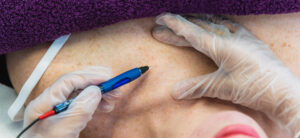
What Causes Cherry Angiomas, also known as Campbell de Morgan spots?
The exact cause of Cherry Angiomas remains unclear, but a combination of genetic and environmental factors is believed to contribute to their development. Common factors that may lead to cherry angiomas include:
- Ageing
Cherry Angiomas are more likely to appear as you age, particularly after the age of 30. Their prevalence increases with age, and they tend to multiply over time. That being said, it is not unusual for young people such as those in their teenage years, to develop these Blood Spots / Cherry Angioma.
- Genetic Factors
If your family has a history of Cherry Angiomas, you are more likely to develop them. Genetics plays a key role in determining who is prone to these skin growths.
- Hormonal Changes
Hormonal shifts, such as those that occur during pregnancy or menopause, can sometimes trigger the development of these Blood Spots / Cherry Angiomas. Certain medications that affect hormone levels may also play a role.
- Sun Exposure
Prolonged sun exposure is another potential contributor to Cherry Angiomas, especially in areas frequently exposed to UV radiation. Protecting your skin from sun damage may help reduce the risk of developing these growths.
- Environmental Factors
Certain environmental factors, such as exposure to chemicals or extreme temperatures, may contribute to the formation of Cherry Angiomas, though this is less common.
Symptoms of Cherry Angiomas
Cherry angiomas are easily identified by their distinct appearance. They are typically:
- Small and round or oval: Cherry Angiomas or Blood Spots, often appear as small, round blood spots, but their size can range from a pinpoint to several millimetres.
- Bright red, purple, or dark in colour: The colour comes from the blood vessels clustered beneath the skin.
- Flat or slightly raised: Some cherry angiomas are flat, while others may be slightly elevated.
- Non-painful and non-itchy: These growths are typically painless and do not cause discomfort. However, they may bleed if scratched or injured.
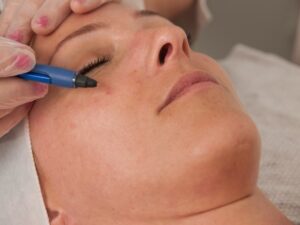
Effective Treatment for Cherry Angiomas
At Skin Revision, we provide a safe and medically approved effective treatment option to remove or reduce the appearance of Cherry Angiomas / Blood Spots. This treatment is non-invasive and has minimal downtime, making it an ideal choice for those looking to address this potentially cosmetic concern.
VeinAway Treatment
VeinAway is a state-of-the-art treatment that uses thermocoagulation to safely target and treat Cherry Angiomas. The procedure involves delivering a controlled radio-frequncy current of intense heat, into the blood vessels within the Angioma. This causes them to collapse and gradually be absorbed by the body’s own lymphatic system, which will then dispurse the residue naturally.
Benefits of VeinAway for Cherry Angiomas:
- Non-invasive: No incisions or needles are required, making the treatment both safe and comfortable.
- Minimal discomfort: Most patients experience only slight discomfort during the procedure.
- Quick recovery: You can resume your normal activities immediately after treatment with no downtime.
- Effective results: VeinAway is highly effective at reducing or removing small to moderate-sized Cherry Angiomas.
- Sun Screen protection: As with any area that has been treated non-surgically, sun protection on the treated area, should be adhered to for at least 48 hours.
Depending on the size of the Cherry Angioma to be treated, a second follow-up treatment may be required within about 3 weeks following the initial treatment. However, VeinAway offers truly excellent results for those seeking an effective solution to remove these blemishes.
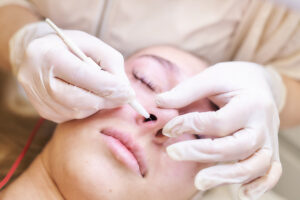
Preventing Cherry Angiomas
While there is no guaranteed way to prevent Cherry Angiomas, although adopting a healthy skincare routine and taking certain precautions may help reduce the risk:
- Use sunscreen: Protecting your skin from harmful UV rays can reduce the risk of sun damage that may contribute to cherry angioma formation.
- Monitor hormonal changes: Hormonal fluctuations, especially during pregnancy or menopause, can trigger Cherry Angiomas. Monitoring your skin during these times may help catch growths early.
- Regular skin checks: Performing regular skin checks can help you detect new Cherry Angiomas or other skin conditions early.
Cherry Angiomas are common, harmless skin growths do not pose any health risks, although their appearance can be bothersome for many people. At Skin Revision, we offer an effective, non-invasive treatment in VeinAway, which will reduce or remove Cherry Angiomas / Campbell de Morgan / lesions, giving you smoother, clearer skin.
If you are concerned about Cherry Angiomas and are interested in exploring your treatment option, contact Skin Revision today to schedule a free phone call consultation. Jacqui Bannister (senior skin expert) will guide you through the process of treating and removing the lesions permanently.
